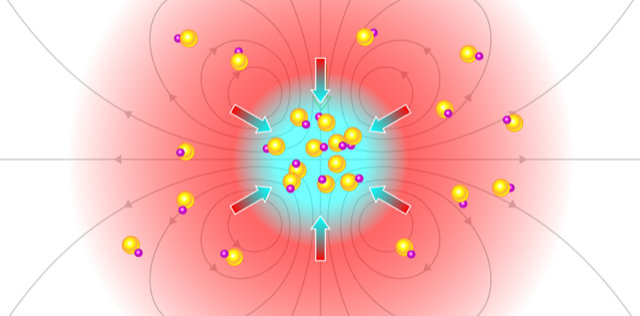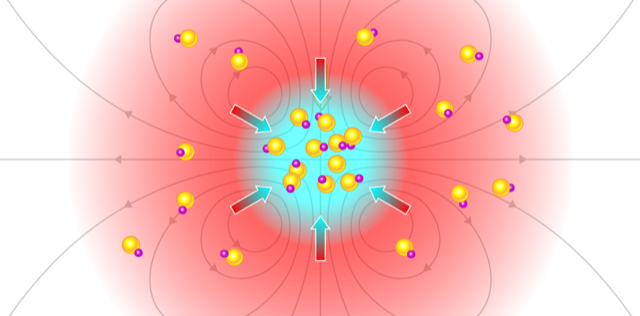A New Way to Laser-Cool Molecules
The study of ultracold atoms has driven major advances in fundamental and applied quantum science for decades—from observing new phases of matter to searching for new fundamental particles and forces. Recently, the quantum community has grown excited about what might be learned from studying controlled quantum interactions between ultracold molecules. With their additional complexity, molecules have more degrees of freedom, offering the possibility to investigate new exotic phenomena. Unfortunately, this extra complexity means that molecules cannot be cooled to ultralow temperatures by simply applying the same methods that produce ultracold atoms. Now, Jun Ye and colleagues at the University of Colorado, Boulder, demonstrate a novel laser-cooling technique that exploits the structural peculiarities of molecules with a nuclear spin and an electron residing on the same species—in their case, the yttrium atom in yttrium monoxide (YO) [1]. By leveraging the unusual structure of YO, the team reaches ultralow temperatures and record-breaking high densities in a laser-cooled molecular gas.
Cooling molecules to the quantum regime—the temperatures at which delicate quantum states are protected from random thermal effects—has many applications within quantum chemistry, many-body physics, and fundamental physics. For example, polar molecules offer a promising platform for quantum simulation, with their electric dipole moments providing strong and tunable interactions. They are also sensitive to the effects of high-energy physics: their large internal electromagnetic fields would amplify hypothetical electromagnetic interactions that are predicted to resolve the Universe’s matter-antimatter asymmetry. Polar molecules’ chemical bonds, meanwhile, offer the ability to study controlled quantum chemistry, in which well-defined quantum states are observed as a chemical reaction takes place.
Currently, in nearly all quantum experiments with atoms, the necessary ultracold temperatures are achieved using laser cooling. This technique works by repeatedly scattering laser photons from the atomic gas to provide a viscous damping force. This force—very much like friction—pushes against the motion of the atoms, and therefore cools the gas. The reason the same cannot be done easily with molecules is that molecules have internal structure. This means that scattering a photon can (and often does) make the molecule rotate or vibrate. In other words, it injects energy into the molecule and stifles cooling.
In the past decade, several groups (including Ye’s) have overcome these challenges and achieved laser cooling and trapping of several molecules: strontium fluoride (SrF) [2], calcium fluoride (CaF) [3, 4], and yttrium oxide (YO) [5]—all of which have an electronic structure particularly suited to laser cooling. These molecules feature a valence electron that acts as though it is bound only to the metal atom. A consequence of this electron localization is that the electron is largely decoupled from the molecular motion, and the electronic transition excited by the laser is unlikely to generate unwanted internal modes. Unlike the metal atoms in SrF and CaF, however, the Y atom in YO has a nuclear spin, which results in a strong electron-nucleus interaction. This “Fermi contact” interaction produces a rather different electronic structure compared to SrF and CaF, and it changes the magnetic properties of the entire molecule. Ye and colleagues use these altered magnetic properties to their advantage to design a new cooling scheme.
Molecules that have been cooled by interacting with photons warm up again when their excited states decay spontaneously, and the absorbed photons are re-emitted in random directions. This process sets a lower limit—called the Doppler limit—on the temperature achievable using simple laser cooling. The Heisenberg energy-time uncertainty principle states that longer timescales between these random, spontaneous photon-emission events are needed to achieve lower energies, and therefore, temperatures. Cooling methods that go below the Doppler limit therefore rely on engineering coherent quantum states that last longer than the short-lived excited electronic state. Magnetic fields can scramble the wave functions of the molecules and destroy this coherence, meaning magneto-optical traps (MOTs), which employ magnetic fields to confine and compress molecules, are used at the expense of higher temperatures.
The Colorado group’s scheme is less sensitive to these magnetic fields because the strong electron-nucleus interaction in YO makes the electron and nucleus “pair up” such that their magnetic moments cancel out. This lets the researchers utilize MOTs without compromising the cooling effects of sub-Doppler methods, and it allows them to combine low temperatures with high densities (Fig. 1). With this technique, the researchers approximately match the 5 𝜇K temperature obtained using sub-Doppler methods to cool CaF, the previous low-temperature record holder [6, 7]. But they achieve a density about 4 times higher. In terms of phase-space density—a measure of how “quantum” a gas is, based on the degree to which the molecules’ de Broglie waves overlap—Ye’s team breaks the record for molecules in free space. This puts their ultracold YO gas closer to the quantum regime than researchers have managed with other molecular species.
Such trapped polar molecules with high phase-space density are a frontier in the study of strongly interacting quantum systems, as strong dipole-dipole interactions are more robust in gases of molecules than of atoms. To realize many of the exciting applications that this property makes possible, researchers need to hold ultracold gases in optical dipole or tweezer traps. Unlike MOTs, these “conservative” traps can control ultracold gases for long periods of time without changing the internal states of the molecules. But loading these traps requires sub-Doppler temperatures and high densities. The team’s new method will therefore be extremely useful in this respect.
Achieving a record high density is noteworthy in itself; doing so with YO offers unique opportunities in molecular physics. For example, using SrF and CaF, researchers have had access only to molecules with single fluorine bonds. As the first ultracold oxide, YO has a double bond to a different species, making it a compelling molecule for the study of ultracold chemical reactions. Additionally, while the structure of YO that enables these new methods is different compared to existing laser-cooled molecules, it is not unique among all molecules. Importantly, many other polar species that could be cooled using this new method also include a heavy metal with a nuclear spin, like YO. As heavier species contain more charges and therefore stronger internal electromagnetic fields, other ultracold molecules could be even more sensitive to nuclear interactions, such as the weak force, and possibly, interactions that aren’t described by the standard model.
This research is published in Physical Review X.
References
- S. Ding et al., “Sub-Doppler cooling and compressed trapping of YO molecules at 𝜇K temperatures,” Phys. Rev. X 10, 021049 (2020).
- J. F. Barry et al., “Magneto-optical trapping of a diatomic molecule,” Nature 512, 286 (2014).
- L. Anderegg et al., “Radio frequency magneto-optical trapping of CaF with high density,” Phys. Rev. Lett. 119, 103201 (2017).
- S. Truppe et al., “Molecules cooled below the Doppler limit,” Nat. Phys. 13, 1173 (2017).
- A. L. Collopy et al., “3D magneto-optical trap of yttrium monoxide,” Phys. Rev. Lett. 121, 213201 (2018).
- L. Caldwell et al., “Deep laser cooling and efficient magnetic compression of molecules,” Phys. Rev. Lett. 123, 033202 (2019).
- L. W. Cheuk et al., “Λ-enhanced imaging of molecules in an optical trap,” Phys. Rev. Lett. 121, 083201 (2018).





